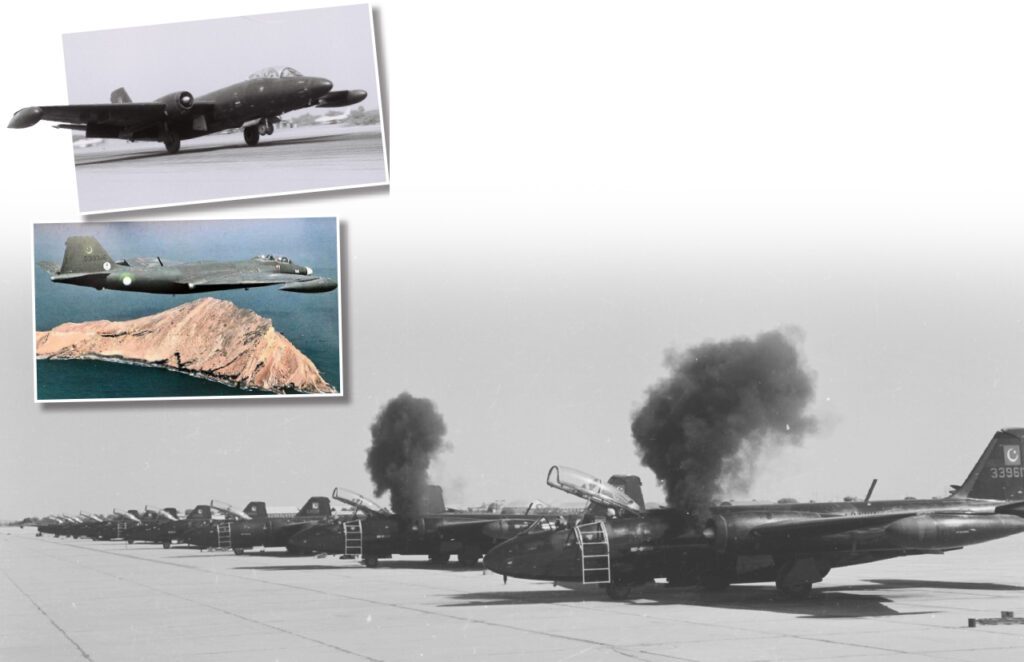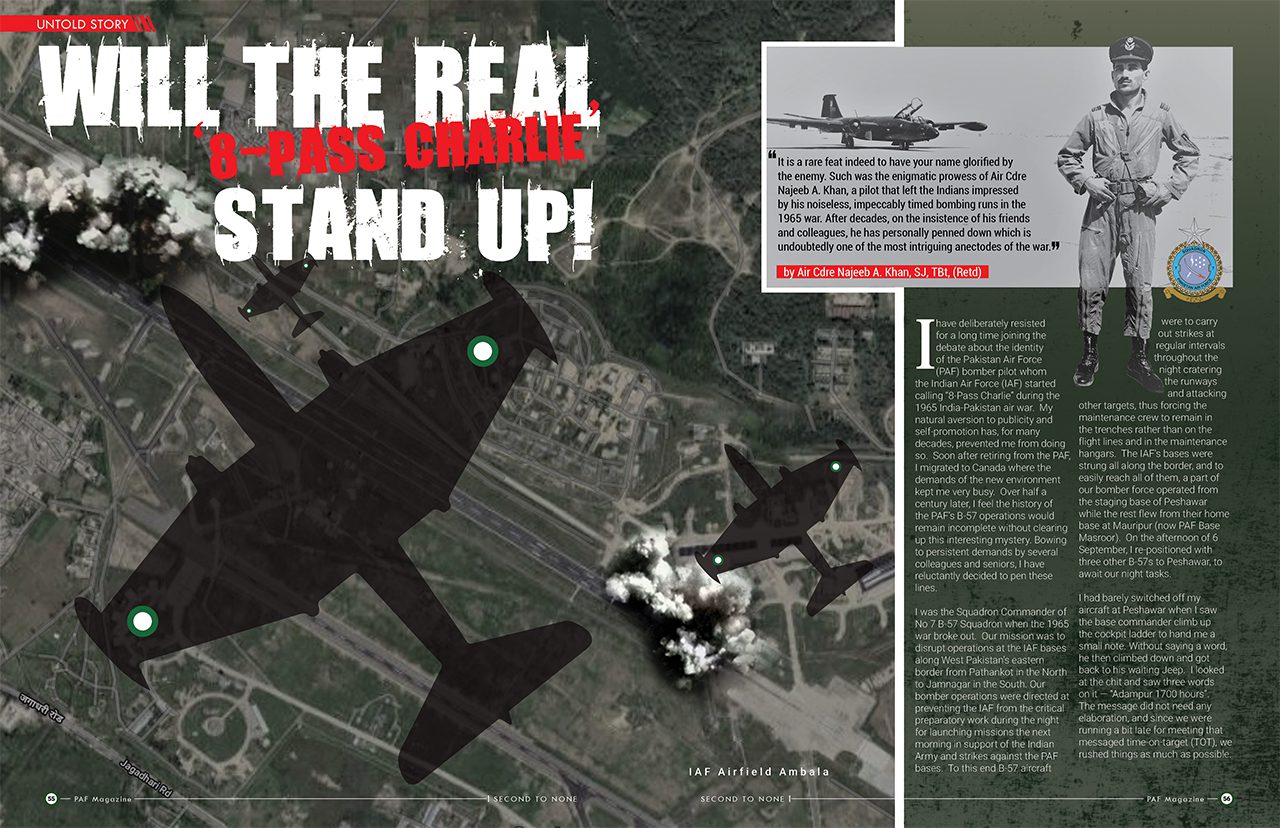It is a rare feat indeed to have your name glorified by the enemy. Such was the enigmatic prowess of Air Cdre Najeeb A. Khan, a pilot that left the Indians impressed by his noiseless, impeccably timed bombing runs in the 1965 war. After decades, on the insistence of his friends and colleagues, he has personally penned down which is undoubtedly one of the most intriguing anectodes of the war.
I have deliberately resisted for a long time joining the debate about the identity of the Pakistan Air Force (PAF) bomber pilot whom the Indian Air Force (IAF) started calling “8-Pass Charlie” during the 1965 India-Pakistan air war. My natural aversion to publicity and self-promotion has, for many decades, prevented me from doing so. Soon after retiring from the PAF, I migrated to Canada where the demands of the new environment kept me very busy. Over half a century later, I feel the history of the PAF’s B-57 operations would remain incomplete without clearing up this interesting mystery. Bowing to persistent demands by several colleagues and seniors, I have reluctantly decided to pen these lines.
I was the Squadron Commander of No 7 B-57 Squadron when the 1965 war broke out. Our mission was to disrupt operations at the IAF bases along West Pakistan’s eastern border from Pathankot in the North to Jamnagar in the South. Our bomber operations were directed at preventing the IAF from the critical preparatory work during the night for launching missions the next morning in support of the Indian Army and strikes against the PAF bases. To this end B-57 aircraft were to carry out strikes at regular intervals throughout the night cratering the runways and attacking other targets, thus forcing the maintenance crew to remain in the trenches rather than on the flight lines and in the maintenance hangars. The IAF’s bases were strung all along the border, and to easily reach all of them, a part of our bomber force operated from the staging base of Peshawar while the rest flew from their home base at Mauripur (now PAF Base Masroor). On the afternoon of 6 September, I re-positioned with three other B-57s to Peshawar, to await our night tasks.
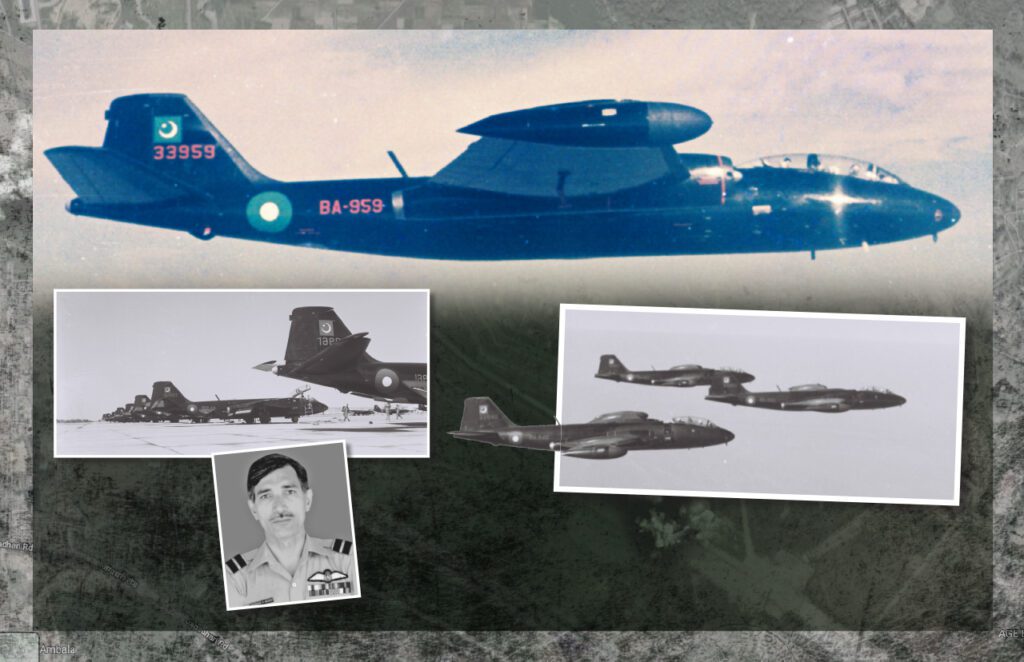
I had barely switched off my aircraft at Peshawar when I saw the base commander climb up the cockpit ladder to hand me a small note. Without saying a word, he then climbed down and got back to his waiting Jeep. I looked at the chit and saw three words on it — “Adampur 1700 hours”. The message did not need any elaboration, and since we were running a bit late for meeting that messaged time-on-target (TOT), we rushed things as much as possible.
Flying low level as we crossed the border into India, the sky darkened; I asked my formation members to stagger behind me at 10-minute intervals. As the lead aircraft in the stream, I pressed on towards the target on our first real-life war mission. It was no longer the usual low-level approach to the bombing range; this was going to be the real thing.
At that stage, our primary concern was accurate night navigation to reach the target (no super inertial systems or GPS in those days), my navigator and I concentrated on that critical task. Soon the moment of truth arrived, and I pulled up for the attack. As the field of vision expanded with rising altitude, I looked out for the target. In a picture-perfect manner, Adampur airfield emerged into view exactly where it was supposed to – at 10 o’clock about 3-4 miles to the left. By now it was quite dark, and we didn’t think the Indian fighter pilots or ack-ack gunners would be able to spot us easily. As I manoeuvered to position for attacking the beginning of runway 31, I was surprised to see that all lights at the base, including the runway lights were on. The runway was an easy target lengthwise, but its limited width still required lateral accuracy. For this mission, we carried 4 x 1,000 lb bombs, and we dropped one bomb in each dive to increase the chances of scoring direct hits. When I exited after spending about 8 minutes over the target, all the lights were still on. The remaining three aircraft had no difficulty reaching the target as the exploding bombs of the aircraft ahead acted as homing beacons. Having delivered our attacks, all four aircraft returned safely in just under two hours. Our first mission had gone on perfectly. It seemed to be a lot simpler than the one we had visualized before taking off.
However, it was not risk-free, as we soon found out. The ground crew discovered a 40 mm hole in the wing of the second bomber, between the fuselage and the left engine, about five feet from the cockpit. On seeing it, we realized it was a close call indeed. Luckily the shell had missed both the cockpit and the engine, and pierced the wing at a point where there was nothing between the top and bottom layers of the wing’s skin. The maintenance crew quickly patched up the holes, and the aircraft was ready to fly again. Happy with the way we had breezed through our first war mission, we did not make much of this incident at the time. Encouraged by our first successful mission, we prepared for our next tasks, entering the first night of our routine of two sorties per night. That was the usual tasking for each bomber team, night after night.
As the war progressed and as a Squadron Commander keen on improving bombing accuracy, I decided to experiment with some reasoned tactics and to set an example of how our missions could be made more effective. All pilots who have done dive-bombing with WW2 vintage (dumb) bombs know that steeper dive angles tend to improve accuracy. So, it stood to reason to make the dive angles substantially steeper than usual. However, steeper dive angles made the aircraft accelerate rapidly towards the ground and severely limited the time available to the pilot during which to manoeuvre the B-57 bombsight onto the aiming point. Equally, steep dives tended to expose the pilot to more risky pull-out heights.
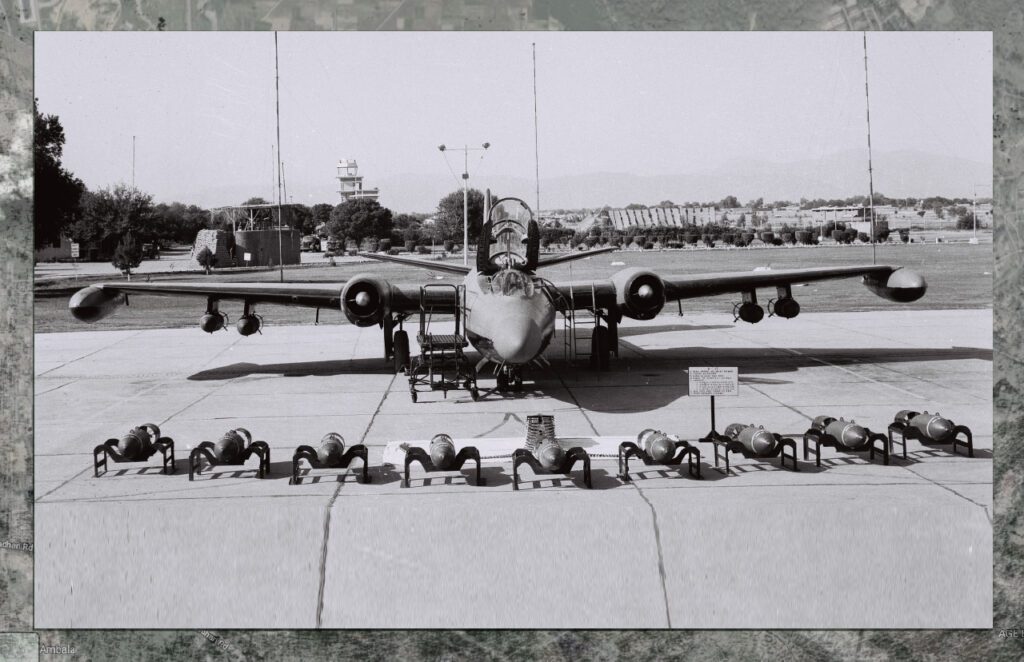
To solve the two issues, it was necessary to slow down the closure rate to the ground. To that end, I decided to reduce my dive-entry speed and to pull the throttles back to idle while entering the steep dive, and to use recalculated bomb trajectory and bombsight settings. For some attacks with dive angles of 55-60 degrees, it was necessary to extend the speed brakes to control the bomber’s rapid acceleration towards the ground. This technique gave me the required additional seconds for proper aiming on the chosen target. As soon as I had pressed the bomb release button, I would shift my focus to pulling out of the dive. Once the B-57 was safely pointing towards the sky and still climbing under the energy it had gained during the dive, I would move the throttles to full power to gain height and re-position for the next attack. Encouraged by the success in the just-completed attacks, we would eagerly manoeuvre to enter the next. The sight of the secondary explosions and fires that we had set off gave us a fair idea of how our bombing had improved. On some occasions in the pitch-dark blackout nights, the fires that we started served as a welcome navigation aid to the B-57s following ours at 15-30 minute intervals.
Ground intelligence from one of the targeted airfields reported that one morning, an IAF Station Commander had even gathered his pilots on the runway targeted by the B-57s on the previous night. He then pointed to the craters on the runway, and to demand from them a similar quality of attacks on the PAF airbases. In other cases, the damage and disruption of high-value targets have also been described by the IAF’s senior commanders. In yet another case, intelligence conveyed that after the bulk fuel storage was hit at Adampur, the station was forced to relocate its aircraft to another base where fuel was available.
Although with the modified parameter change in the dive angle the bomb impacts became more accurate, I shared this method with only the most experienced pilots, to avoid exposing younger pilots to unnecessary risks. This care was necessary also because no central briefings could be held as our bomber teams operated from busy and dispersed sites. There was also no time for additional supervised training during the war.
It was more than a decade later that I learned from several personal accounts how the IAF pilots were impressed by the persistent and rather unique profiles of my raids. The repeated experience – from the Indian trenches – of an enemy bomber’s engine noise cycling between the roar of full throttles to eerie silence every three minutes left the witnesses guessing about what the pilot was trying to do. I knew, of course, but even now can fully appreciate the confusing effect that the sounds of my bombing profile must have been causing below! Meanwhile, unknown to me, the IAF pilots sheltering on the ground and not knowing who it was, had given me the nickname of “8-Pass Charlie”. Over several nights, they learned quickly to recognize me by the sound of my attacks whenever I was targeting their base. As time passed, I found it fascinating to come across many Internet and other media messages from those IAF witnesses who had lived through my attacks. I was told that while in the trenches, some of them had developed a sense of respect for the grit of the unknown enemy pilot. A few soft-hearted ones among them admitted even to secretly hoping that the PAF pilot would escape the scores of ack-ack guns that would be continuously firing at his plane.
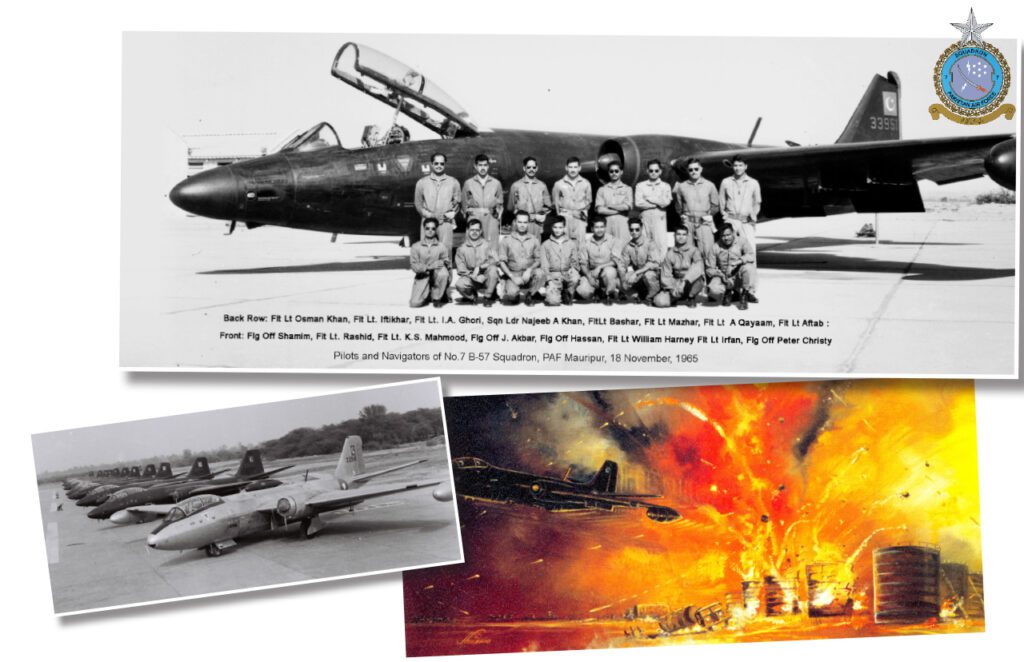
The accounts of Wing Commander Paddy Earle of the IAF and Indian war historian Samir Chopra have highlighted yet another facet of this story. I think it was Wing Commander Paddy Earl who – conferring on me the Americanized title of a “cool dude” – even suggested that I was pulling my throttles back to idle before entering a dive to deceive the anti-aircraft gunners about my actual position in the sky. I must admit that those anti-aircraft gunners still did their best. I do recall seeing anti-aircraft shells catching up to my wingtips in volleys of four, and then lagging behind as my aircraft seemed to out-climb them under full power.
In conclusion, this writing is to unmask the anonymity of the “8-Pass Charlie” for the sake of putting the historical facts in a proper perspective. It also serves as a long-delayed admission on my part of being the one – the only “8-Pass Charlie” – recorded in the IAF history. It is quite a unique distinction for combat pilots to be bestowed with such catchy titles. The two nicknames were exceptional because both came voluntarily from the enemy camp, while acknowledging high military daring and professionalism. On the formal side of history, the role played by No 7 B-57 Squadron is well illustrated by the award of 14 gallantry medals to its aircrew. All those medals were won for performance under fire, and all were Sitara-e-Jurats (or SJs, equivalents of the British DFCs) – a record for the 1965 War. In the broader context of the 1965 B-57 operations, including my role in it, there is ample evidence from ground intelligence as well as post-war accounts written by the IAF’s senior commanders and others.
The comments and writings of Indian authors and the IAF pilots highlight an aspect of my missions that would have passed unnoticed had they not commented on it. The IAF’s interpretation of my motive came as a complete surprise to me since I hadn’t ever thought that diving with throttles at idle would deny the ack-ack gunners the ability to fix the location of my bomber by the sound of its engines. My power-less dives did indeed deny that advantage to the Indian gunners, however unintended that effect was on my part. But ack-ack gunners don’t stop firing just because the target’s volume of sound suddenly drops. In reality, I saw that they continued to fire relentlessly and locked on to the sound of my engines as soon as they picked it up again. While concentrating on my dive and aligning the bombsight with the target, I was aware of the hundreds of shells forming a sphere of glowing red balls over the airfield. The shells fired from numerous points on the airfield perimeter crisscrossed in front, on the sides, above and below me forming a lethal red dome over the airbase.
All those gunners who were pointing their guns at me were obviously hoping that some of their shells might cross paths with my B-57. My reaction to this display of fireworks was to tell myself “Ignore, and do your job”. The observers on the ground could understandably think that my use of dives at idle power was merely stealth to become invisible to the gunners’ aim. However, my motivation for doing so was a different one: As a professional in the line of duty, to focus intently on making my mission as effective as I possibly could, in the righteous defence of my country.
